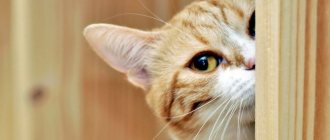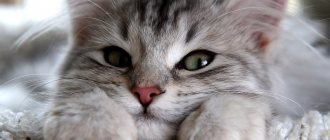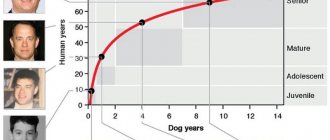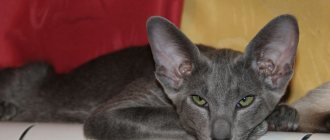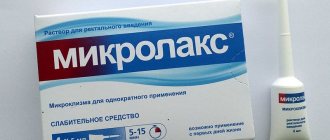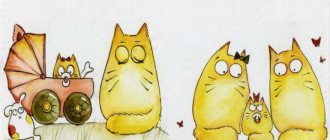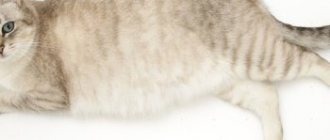It is generally accepted that one cat year corresponds to seven human years, but this is not an accurate method of calculation.
In this case, a one-year-old pet, who is already capable of having his own kittens, should just go to school. An 8-year-old cat is already retiring according to this formula.
Any owner of a furry cat will understand that this is absurd: small kittens develop very quickly, but mature cats do not change for years. Let's figure out how to correctly convert a cat's age to human age.
Cat to human age ratio
There is no clear linear relationship between cat and human age, so it is difficult to calculate how many human years a cat has.
An approximate conversion of a cat's age to a human age is presented in the table. Table 1 - Comparison of the ages of cats and humans
| Age periods | Cat | Human |
| Childhood | 1 month | 6 months |
| 2 months | 10 months | |
| 3 months | 2 years | |
| 4 months | 5 years | |
| 5 months | 8 years | |
| 6 months | 14 years | |
| 7 months | 15 years | |
| 8 months | 16 years | |
| Youth | 10 months | 17 years |
| 1 year | 18 years | |
| Youth | 2 years | 25 years |
| 3 years | 30 years | |
| 4 years | 35 years | |
| Maturity | 5 years | 40 years |
| 6 years | 43 years | |
| 7 years | 45 years | |
| 8 years | 50 years | |
| 9 years | 55 years | |
| 10 years | 60 years | |
| Elderly age | 11 years | 62 years old |
| 12 years | 65 years old | |
| 13 years | 68 years old | |
| 14 years | 72 years old | |
| 15 years | 74 years old | |
| Senile age | 16 years | 76 years old |
| 17 years | 78 years old | |
| 18 years | 80 years old | |
| 19 years | 90 years old | |
| 20 years | 100 years |
Life stages of cats
In cats, it is customary to distinguish three main stages of life - childhood and adolescence, youth and maturity, old age and old age. During these periods, the animal’s behavior and its relationship with the outside world change.
Childhood and youth
Childhood and adolescence are a period of learning useful skills and learning about the world. During this period, animals are especially active and energetic. By the age of two months, kittens develop normal coordination of movements, they feed independently and know how to use a litter tray. 2-3 months is the optimal age for handing over babies to new owners. Puberty begins at 4-6 months. By the age of one year, cats become fully grown, capable of obtaining food by hunting and bearing offspring. During childhood and adolescence, animals are still inexperienced, but curious, active and fearless, susceptible to infections, so at this stage you should create the safest possible living environment for them.
Youth and maturity
Young cats retain their youthful excess of energy and continue to gain life experience. During this period, the immune system finally matures. From 3-5 years old, animals become calmer, although they are not averse to playing with their owner and spend a lot of time hunting (including inanimate objects). Their regime is measured - food, entertainment and rest on a schedule. Cats are usually more self-sufficient; cats are more attached to their owner. This is the heyday of cat life, procreation.
Elderly and senile age
Elderly cats are calm and complacent; they like to be alone and sleep. These are wise animals that understand the person they love and trust perfectly. They are more conservative and often react to changes in the environment with stress and irritation. During this period, the immune response and the ability to thermoregulate weaken – the pet becomes sensitive to infections and does not tolerate heat and cold well. Elderly animals often react painfully to the arrival of a new pet in the house. At the end of its life, a cat needs to be protected from any changes and stress, and given enough attention.
Fairness of the matching rate
If we approach the question of how to calculate the age of a cat with all rigor and seriousness, then the second method of determining it also cannot be called absolutely accurate.
The animal psyche is structured completely differently from that of a human. For this reason, there is no need to perceive a two-year-old pet as a completely adult animal with fully formed intelligence and a high level of social adaptation. Measuring cat intelligence seems to be quite a difficult task. That is why there are no completely objective and accurate ways to determine the age of a pet in the world.
Note: As mentioned earlier, as a cat grows up, its behavior is characterized by the following features:
- weak expression of playfulness;
- decreased interest in the outside world;
- calmer, more serious, balanced behavior.
However, there are cases when an animal retains spontaneity, curiosity, playfulness and other childish traits characteristic of kittens and young cats until the end of its life.
How to determine the age of a cat by external signs
It is extremely difficult to determine the age of an adult cat by its appearance. Often animals of very advanced age do not look decrepit and weak. If the age of the new pet is unknown, you can try to find it out using the following parameters:
- Teeth. The only reliable criterion for determining age is the appearance and change of teeth - useful only for kittens. At 2-3 weeks, babies develop incisors, at 3-4 - canines, at 3-6 - premolars. Then, at 3-4 months, the incisors change, and at 4-6 months, the remaining teeth. By 7 months, the change of teeth is completed. After 1-1.5 years, a yellowish coating appears on the surface of the teeth, which becomes more intense over the years. Age-related tooth loss is an individual factor: some 16-year-old cats can boast a fully “complete” toothy mouth, and in some, dental diseases accompanied by tooth loss occur as early as one year of age.
- Wool. Until old age, healthy cats have a smooth and shiny coat and a dense undercoat. Then the undercoat thins out and the coat becomes less smooth. In long-haired animals in old age, a decrease in the volume of the tail due to wool is clearly noticeable. After 8-10 years, individual gray hairs may appear (total graying, as in humans, does not occur in cats). In old people, the fur becomes dull, the mustache thins and shortens.
- To the eyes. Up to 1-2 years, cats will retain “kitten” curiosity and enthusiasm in their eyes, even during rest. Older individuals look at the world more calmly and lazily. After 10-12 years, the eyes begin to gradually “sink”, but their clarity remains until old age, if the pet is healthy.
- Conditions. The body of young cats feels soft and plastic, and after 5 years it becomes denser, as if “hardening” (which does not in any way affect their dexterity). After 8-10 years, the contours of the cheeks, chin and body become less rounded. In old age, the muscular system and fat layer undergo dystrophic changes, the animal loses weight and “shrinks out.”
- Musculoskeletal system. The condition of the musculoskeletal system in cats changes little over the years, so gait practically does not change with age, and the ability to jump high remains in old age. Joint stiffness with a noticeable decrease in physical activity is typical in old age
A veterinarian can more accurately determine the age of a cat by examining the fundus of the eye or by the condition of the internal organs during surgery.
Breed, living conditions and other factors affecting life expectancy
If it is important for the owner of the animal how to calculate the age of a cat by human standards, then he should pay attention to the characteristics of the Murka breed.
Ordinary “mongrel” cats live longer than others, as well as representatives of old breeds, untouched by the delights of modern selection.
Pedigree cats with exotic “flavors” in appearance (flat ears, short “stubbed” tails, short legs) cannot boast of the ability to live longevity, since the genetic code is so altered that a cute, non-standard appearance entails huge problems with the health of the animal.
Pedigree cats cannot boast of longevity
If the owner is interested not only in what age his cat is by human standards, but also in how to prolong the life of a mustachioed pet, then he will definitely adhere to the standards for keeping the animal, prepare the right diet for it, surround it with care and affection, and protect it from stressful situations.
Long-lived cats
Famous cats and cats - record holders for life expectancy:
- Lucy the cat – 39 years old (born in 1972, the record was registered during the cat’s lifetime in 2011), South Wales, UK
- Cat Cream Puff – 38 years old (1967-2005), Texas, USA
- Baby Cat – 37 years old (1970-2007), Minnesota, USA
- Cat Granpa Rex Allen - 34 years old (1964-1998), Texas, USA
- Scooter the Cat – 30 years old (1986-2016), Texas, USA
In the photo, the long-lived cat Cream Puff
There is no relationship between the breed of a cat and its lifespan. Representatives of indigenous breeds (Norwegian Forest, Siberian, Maine Coon) were distinguished by good health and longevity until they were affected by mass artificial breeding.
Maturity (10-15 years)
A cat at this time can be compared to a person from 40 to 60 years old. Both humans and cats need to carefully monitor their health at this time (the owner must do this for the cat). For example, it is worth increasing your visits to the veterinarian to twice a year. But with proper care, she will still be healthy and happy with life. Like people, cats become more inclined to calmness and tranquility, and will often prefer the gentle purring of their owners. But from time to time they won’t mind playing.
How to extend the life of a cat
The following factors influence a cat's lifespan:
- Self-walking. Vagrancy should be avoided; in urban conditions, letting a cat out of the house unattended is doubly dangerous. Such walks often end in injury, incurable infection (viral leukemia, immunodeficiency) and death. It is better to fence the dacha area so that the cat cannot leave its boundaries, or equip it with a spacious enclosure.
- Nutrition. The diet should be fresh, balanced, and appropriate to the age of the animal. Industrial feed should be chosen at least premium class. If ready-made food is not suitable for some reason, the cat should be prepared separately; you should not feed it food from the human table.
- Regular vaccination. It is necessary to vaccinate all pets, including those who do not leave the house (the causative agent of the infection can come from the outside, from the owner’s shoes or clothes).
- Control of reproduction. It is best to neuter your pet. In fertile cats, do not give birth more often than once every 1-2 years (at the age of no earlier than 2 years and no later than 6-7).
- Veterinary control. At the first sign of illness, your pet should be seen by a doctor. For older cats, an annual preventive examination is recommended, including a general examination, blood, urine and feces tests, and consultation with a cardiologist.
- Living conditions. The cat should have a resting place in the house, where no one will disturb it, and enough toys for active pastime. The litter tray must be placed in a secluded place and kept clean.
Compliance with the rules of keeping, love, creating a calm and friendly atmosphere in the house is the key to a happy and long life for your pet.
What does lifespan depend on?
A balanced diet is an important factor influencing life expectancy. If the pet receives all the necessary vitamins, then the process of tooth wear and aging of the body is noticeably reduced. Only a professional doctor can choose the right diet based on examination and tests of the animal. In this matter, you should not trust solely the recommendations of consultants at the pet store.
Cats live a long time in a comfortable home environment. Veterinarians advise keeping pets vaccinated on time. Scientists agree that spayed and neutered cats live longer than those who continue the breed.
